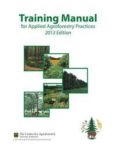Agroforestry practices help landowners diversify products, markets, and farm income; improve soil and water quality; and reduce erosion, non-point source pollution and flood damage. The integrated practices of agroforestry enhance land and aquatic habitats for fish and wildlife and improve biodiversity while sustaining land resources for generations to come.
Developed by the The Center for Agroforestry at the University of Missouri in 2013, the Training Manual for Applied Agroforestry Practices and the Handbook for Agroforestry Planning and Design are companion pieces that provide easy-to-use information about agroforestry.

Handbook for Agroforestry Planning and Design
The steps provided in the Handbook for Agroforestry Planning and Design will allow you to identify what agroforestry products can grow on your land, which of these products you can sell profitably, and how to develop basic business and marketing strategies.

Training Manual for Applied Agroforestry Practices
The Training Manual for Applied Agroforestry Practices helps to explain agroforestry practices and their applications. It is designed for natural resources professionals and landowners, and includes worksheets and exercises for use as an educational tool. Additionally, the manual is designed to assist in the decision process so that, when established or managed, the agroforestry practice is most effective at achieving the desired objectives.
Want more information? See the related SARE grant:
- Increasing Agroforestry Adoption and Networking in the Midwest through Targeted Professional Development (ENC12-129)
This material is based upon work that is supported by the National Institute of Food and Agriculture, U.S. Department of Agriculture through the Sustainable Agriculture Research and Education (SARE) program. Any opinions, findings, conclusions, or recommendations expressed in this publication are those of the author(s) and should not be construed to represent any official USDA or U.S. Government determination or policy.
